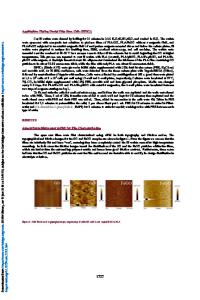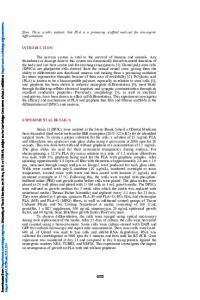The Influence of Metalized Graphene Oxide/Reduced Graphene Oxide and Sulfonated Polystyrene on Dental Pulp Stem Cell Dif
- PDF / 1,269,447 Bytes
- 12 Pages / 612 x 792 pts (letter) Page_size
- 103 Downloads / 379 Views
The Influence of Metalized Graphene Oxide/Reduced Graphene Oxide and Sulfonated Polystyrene on Dental Pulp Stem Cell Differentiation and Protein Adsorption Rachel Sacks1, Gila Schein1, Rebecca Isseroff2, Vincent Ricotta3, Marcia Simon4, and Miriam Rafailovich3 1
Hebrew Academy of the Five Towns and the Rockaways, Cedarhurst, NY 11516 Lawrence High School, Cedarhurst, NY 11516 3 Stony Brook University, Stony Brook, NY 11794 4 Stony Brook University School of Dental Medicine, Stony Brook, NY 11794 2
ABSTRACT Human dental pulp stem cells (DPSCs) can differentiate, showing potential for regenerative medicine. Designing artificial surfaces with properties appropriate for the initiation of extracellular matrix (ECM) adsorption and organization is a critical step in tissue engineering and can greatly impact protein adhesion. Sulfonated polystyrene (SPS), used as a scaffold for tissue development, stimulates protein adsorption due to the increased negative charge of sulfonate. Graphene and graphene oxide (GO) sheets enhance stem cell growth and differentiation because they are soft membranes with “high in-plane” stiffness and have the potential to be transferable and implantable platforms. This project functionalized GO and reduced GO (RGO) with gold or silver nanoparticles, mixing with SPS to investigate their combined impact on DPSC differentiation and protein adsorption, hypothesizing that this combination supplies more charges to better absorb the proteins to the surface and stimulate differentiation. Results indicate that proteins of cells plated on the gold-RGO/SPS surfaces were the most highly adsorbed and most densely packed. Additionally, the cell moduli data indicated that the metal-RGO solutions substantially induced a change in modulus even more than Dexamethasone, a glucocortoid known to enhance this process in DPSCs. This suggests that the metal-RGO solutions may be instrumental in osteogenic induction. INTRODUCTION Dental pulp stem cells (DPSCs), which can be derived from human exfoliated deciduous teeth, can differentiate into neurons, cardiomyocytes, chondrocytes, osteoblasts, liver cells and β cells of islet of pancreas and therefore show great potential for use in regenerative medicine and tissue engineering [1]. The first step in tissue development revolves around the adhesion and organization of the extracellular matrix (ECM) proteins, molecules secreted by cells that provide structural and biochemical support and that also initiate biochemical and biomechanical signals required for tissue differentiation. Therefore, advances in tissue engineering are dependent upon the ability to regulate the self-organizing properties necessary to initiate tissue development – mainly, the cells’ interactions with ECM proteins. Many of the crucial ECM proteins are reliant upon surface interactions to begin the process of nucleation [2]. Therefore, the design of artificial surfaces with properties appropriate for the initiation of ECM adsorption and organization serves as a critical step in tissue engineering and can
Data Loading...











